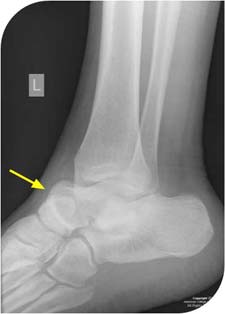How much dose do I get from different imaging procedures?
When it comes to radiation dose, all imaging procedures are not the same. Some procedures, like ultrasound and magnetic resonance imaging (MRI), do not use ionizing radiation. Procedures that use ionizing radiation (like standard x-ray or computed tomography) or radioactive materials (nuclear medicine) vary widely in dose. Radiation dose depends on the type of procedure and the part of the body being examined.
Potential risk can be expressed in different ways. Radiation dose can be compared to levels from naturally existing radiation in the environment, or compared with doses allowed for those who are exposed to radiation as part of their work. Sometimes radiation dose is described more specifically in units or terms that relate to the type or extent of the exposure.
Effective dose

Ankle x-ray
Effective dose is the dose quantity that is used to assess risks from diagnostic medical imaging procedures. It is typically expressed in millisieverts (mSv).
Effective dose takes many factors into account, including the sensitivity of different body organs and tissues.
For example, an ankle x-ray has a different effective dose than a coronary angiogram.
However, effective dose is not intended to apply to a specific patient. It is an estimated risk based on an average person. The actual risk to a patient might be higher or lower, depending on the size, gender, or health of the patient as well as the type of procedure.
Natural background radiation in the United States
We are always exposed to background radiation. It comes from the air, sky, ground and the food we eat. It is natural to our environment.
To put dose from medical imaging in perspective, we compare imaging dose to the time it takes to reach the same dose from natural background radiation.
Over one year's time, our dose from natural background radiation is approximately 3 mSv.
 Qualitative risk levels
Qualitative risk levels
Negligible risk: less than 2 days of natural background exposure
Minimal risk: more than 2 days and up to 1 month of natural background exposure
Very low risk: more than 1 month and up to 8 months of natural background exposure
Low risk: more than 8 months and up to 6 years of natural background exposure
Moderate risk: more than 6 years of natural background exposure
View table showing summary of radiation doses for a variety of procedures
This page was reviewed on June 07, 2024


